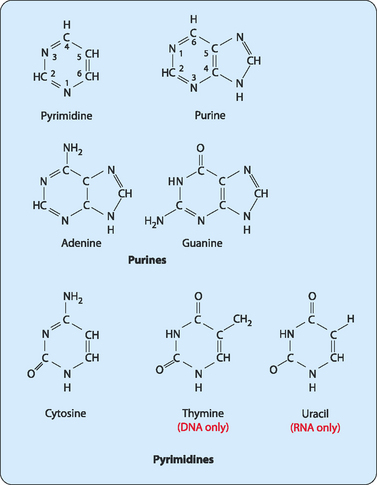chapter 9 Nucleic acids: biological molecules for information storage, retrieval and usage
 RNA is found as three major forms in cells: messenger RNA, transfer RNA and ribosomal RNA, all of which are involved in protein synthesis.
RNA is found as three major forms in cells: messenger RNA, transfer RNA and ribosomal RNA, all of which are involved in protein synthesis.Nucleic acids were first discovered by Friedrich Miescher in 1871. Miescher identified a phosphate-rich cellular substance from the nucleus of white blood cells that he called ‘nuclein’. It was later discovered that nucleic acids are macromolecules synthesised by the polymerisation of monomeric subunits known as nucleotides, with a sugar-phosphate backbone linked by ester bonds. Nucleic acids are primarily involved in the storage and expression of the genetic information of the cell, but also play structural roles. In cells the two forms are deoxyribonucleic acid (DNA) and ribonucleic acid (RNA). At least one form of nucleic acid is found in all living things, including all cells and viruses. The discovery of the structure of DNA by Crick, Watson and Wilkins, who received a Nobel Prize in 1962, has been heralded as one of the most important scientific discoveries of the twentieth century.
The general structure of nucleic acids
The building blocks of nucleic acids
Bases in nucleic acids are a family of nitrogenous heterocyclic aromatic compounds (Fig 9-1). Cytosine (C), guanine (G), adenine (A) and thymine (T) are found in DNA, whereas uracil (U) replaces thymine in RNA. All bases can be classified into two groups based on their skeletal structure. Adenine and guanine are based on purine, a molecule that contains two rings, and are referred to as purine bases whereas cytosine, thymine and uracil are referred to as pyrimidine bases, being based on pyrimidine, a single-ring molecule.
Nucleotides are made by adding a phosphate group to a nucleoside (Fig 9-2). They are used as the monomers in RNA and DNA, but are also components of important enzyme cofactors (see Ch 15), such as coenzyme A (CoA), flavin adenine dinucleotide (FAD), flavin mononucleotide (FMN), nicotinamide adenine dinucleotide (NAD), nicotinamide adenine dinucleotide phosphate (NADP) and adenosine triphosphate (ATP). They can also play important roles in other cellular processes such as signalling between or within cells. They are named by modifying the name of the nucleoside they contain together with the number of phosphates they contain. Thus, adenine attached to ribose forms the nucleoside adenosine. Addition of a phosphate to adenosine forms adenosine monophosphate. As further phosphates are added, adenosine diphosphate and then adenosine triphosphate are formed.
Stay updated, free articles. Join our Telegram channel

Full access? Get Clinical Tree












